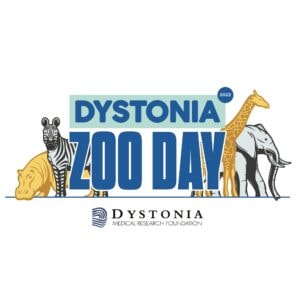VZD with sponsors Show  Kessler Perlmutter Lewis trio Research Lab Funding Dystonia Discoveries Dog Paolero Baron Shining a light on dystonia, and a path forward for every family. Support GroupsThere are many benefits to joining a dystonia support group. Find the support group nearest you and enjoy the rewards.  Get InvolvedYou can connect with others in the dystonia community who are committed to making a difference. Getting involved is empowering.  DonateThe Dystonia Medical Research Foundation (DMRF) has stood up for the dystonia community since 1976. Join us in our global effort to find a cure. Dystonia NewsLatest Developments
Allergan, an AbbVie Company is continuing their long-standing support of the dystonia community by returning as a National Sponsor of the Dystonia Medical Research Foundation’s (DMRF) Dystonia Zoo Days in 2022. The purpose of these events is to bring together
individuals and families affected by dystonia and raise funds in support of the DMRF mission. […]
The DMRF is proud to partially support two Dystonia
Coalition Pilot Project Awards. The goal of the Pilot Projects Program is to foster the most promising clinical and translational studies on dystonia. Moodscreen for Cervical Dystonia: A Diagnostic Accuracy Study of Depression and Anxiety Davide Martino, MD, PhD, University of Calgary Depression and anxiety frequently […]
The 9th Annual “Rockin’ for a Cure” organized by Robin and Marc Miller of New York on July 14 raised $147,000 for urgently-needed dystonia research. The event supported the Cure Dystonia Now Fund of the Dystonia Medical Research Foundation (DMRF). Sponsors included Allergan, an AbbVie Company; Reliance First Capital; and Command Direct. Over the past […] Portland Zoo DayAugust 20, 2022Toledo Zoo DayAugust 27, 2022Pamela Sloate Bronx Dystonia Zoo DaySeptember 10, 2022Boston Zoo DaySeptember 17, 2022Join us, and be a part of the global effort to find a cure for dystoniaCurrent Dystonia Research InvestigationsThe Dystonia Medical Research Foundation (DMRF) prides itself on a long history of supporting and stimulating dystonia research. Normalizing DYT1 Cholinergic Neurons by CRISPR Disruption of Mutant TOR1A Allele Gene therapy is proving beneficial in an increasing number of neurological diseases. This proposal represents a step in evaluating whether gene therapy could be effective in DYT1 dystonia. Dr. Breakefield’s lab has shown that selective disruption of the mutant TOR1A/DYT1 gene can normalize biologic cell functions in patient skin cells. Since dystonia is a neurological disease, the next step is to evaluate whether this approach can normalize function in TOR1A/DYT1 neurons (brain cells). Through the work of Dr. D. Cristopher Bragg and Dr. Nutan Sharma the investigators have access to stem cells from DYT1 patients, which can be turned into neurons. If successful in rescuing neurons, the lab will work with Dr. David Standaert to translate the technology into a mouse model which would provide some of the data needed for the Food & Drug Administration to allow a clinical trial. Ultimately, Dr. Breakefield envisions a clinical trial in which children carrying the mutant TOR1A/DYT1 gene and manifesting symptoms at an early age are administered gene therapy in a single dose. This could be done at the same time as deep brain stimulation (DBS), with the intent to eventually turn off the DBS device to assess if it remains needed. The ultimate goal of this effort is the development of better therapies for DYT1 dystonia. Role of Cerebellar Network Excitability and Plasticity in the Pathophysiology of Dystonia Dr. Pisani and his team are studying brain circuits in two types of genetic dystonia: DYT1 dystonia, which is the most common inherited form, and DYT25 dystonia which is rarer. They are testing the idea that loss of these genes leads to changes in brain plasticity, which is how the brain learns motor tasks and adapts to new environments. They believe that abnormal plasticity is a shared factor responsible for abnormal movements observed in patients. They will study two animal models, one with the DYT1/TOR1A gene mutation and the other with loss of DYT25/GNAO1. By conducting studies on brain circuits in these models, they hope to learn about the effects of the loss of these genes on brain plasticity. One of the features of abnormal movements in dystonia is that once the symptoms develop, they can be difficult to treat and may become permanent. This is a kind of dysfunctional plasticity. Therefore, if investigators can understand the mechanisms and control the abnormal plasticity, they might be able to ‘undo’ the changes in the brain that cause these movements, leading to better treatments. Cerebellar Repetitive Transcranial Magnetic Stimulation in Monogenic Myoclonus-Dystonia Connie and Jim Brown Early Stage Investigator Award Myoclonus-dystonia (M-D) is a neurological movement disorder often characterized by a combination of generalized myoclonic jerks, dystonia, and psychiatric disorders. Mutations in the SGCE and VPS16 genes have been identified as genetic causes of the disease. Both genes are important for the function of an area of the brain called the cerebellum. These investigators and others have demonstrated that individuals with M-D have deficits of cerebellar mediated learning. How cerebellar malfunction in these patients affects the cortex of the brain, particularly regions important for motor control is of particular interest. Dr. Weissbach is leading the first study to investigate potential symptom reduction and neurophysiological changes in M-D patients before and after repetitive non-invasive transcranial magnetic stimulation (rTMS). The study aims to identify the clinical cerebellar deficit, identify abnormalities of cerebellar function and its interaction with the cortex of the brain as well as examine the reversibility of these abnormalities through the application of cerebellar rTMS. These findings will foster development of new treatment strategies. |

Related Posts
Advertising
LATEST NEWS
Advertising
Populer
Advertising
About

Copyright © 2024 SignalDuo Inc.






















